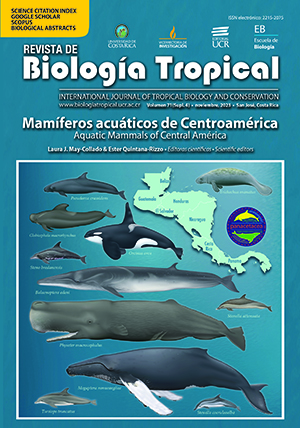Abstract
Introduction: Small populations are at risk of losing genetic variability much faster than large populations; this subsequently decreases their ability to adapt when facing environmental changes. A small population of the endangered Antillean manatee (Trichechus manatus manatus) has been identified in Guatemala.
Objective: This study explored the genetic diversity of the Antillean manatee in Guatemala by analysing mitochondrial DNA control region haplotypes in the two most important habitats for the species, Bahía La Graciosa, a coastal bay and Bocas del Polochic, a coastal wetland, both located in the Izabal State.
Methods: Genetic samples were collected using non or minimally invasive sampling techniques: scraping of epidermal tissue, collection of floating feces, and collection of tissue from carcasses. DNA extractions, DNA amplification using polymerase chain reaction (PCR), and sequencing of the control D-loop region were used to process and analyse the samples.
Results: Seven mitochondrial DNA sequences were obtained from 36 samples collected (minimum of four and maximum of seven individuals). Four haplotypes were identified, A01, A03, A04, and J01. No other Central American country has reported this number of haplotypes in a manatee population, and it is the first time that haplotype A01 has been reported for the region. The Guatemalan manatee population comprises at least two genetic lineages, the Florida/Greater Antilles lineage (haplotypes A01, A03, and A04) and the Mesoamerican lineage (J01).
Conclusion: Further studies, with the use of nuclear markers, are necessary to understand the population dynamics between Bahia La Graciosa and Bocas del Polochic to identify the number of management units present in the country; also, the degree of relatedness with the Belizean population needs to be established to better coordinate conservation efforts.
References
Alvarez-Aleman, A., Hunter, M., Frazer, T. K., Powell, J. A., Garcia Alfonso, E., & Austin, J. D. (2022). The first assessment of the genetic diversity and structure of the endangered West Indian manatee in Cuba. Genetica, 12, 327–341. https://doi.org/10.1007/s10709-022-00172-8
Caballero, S., Ortiz-Giral, M. C., Bohorquez, L., Lozano Mojica, J. D., Caicedo-Herrera, D., Arévalo-González, K., & Mignucci-Giannoni, A. A. (2021). Mitochondrial genetic diversity, population structure and detection of Antillean and Amazonian manatees in Colombia: new areas and new techniques. Frontiers in Genetics, 12, 726916. https://doi.org/10.3389/fgene.2021.726916
Carney, S. L., Bolen, E. E., Barton, S. L., Scolardi, K. M., Englund, C. C., Tringali, M. D., & Reynolds III, J. R. (2007). A minimally invasive method of field sampling for genetic analyses of the Florida Manatee (Trichechus manatus latirostris). Marine Mammal Science, 23, 967–975. https://doi.org/10.1111/j.1748-7692.2007.00155.x
Castelblanco-Martínez, D. N., Alvarez-Aleman, A., Torres, R., Teague, A. L., Barton, S. L., Rood, K. A., Ramos, E. A., & Mignucci-Giannoni, A. A. (2021). First documentation of long-distance travel by a Florida manatee to the Mexican Caribbean. Ethology Ecology and Evolution, 34, 545–556. https://doi.org/10.1080/03949370.2021.1967457
Díaz-Ferguson, E., Hunter, M., & Guzman, H. M. (2017). Genetic composition and connectivity of the Antillean Manatee (Trichechus manatus manatus) in Panama. Aquatic Mammals, 43, 378–383.
García-Rodríguez, A. I., Bowen, M., Domning, D. P., Mignucci-Giannoni, A. A., Marmontel, M., Montoya-Ospina, R. A., Morales-Vela, B., Rudin, M., Bonde, R. K., & McGuire, P. M. (1998). Phylogeny of West Indian manatee (Trichechus manatus): how many populations and how many taxa? Molecular Ecology, 9, 1137–1149. https://doi.org/10.1046/j.1365-294x.1998.00430.x
Höss, M., & Pääbo, S. (1993). DNA extraction from Pleistocene bones by a silica-based purification method. Nucleic Acids Research, 21, 3913–3914. https://doi.org/10.1093/nar/21.16.3913
Hunter, M. E, Auil-Gomez, N. E., Tucker, K. P., Bonde, R. K., Powell, J., & McGuire, P. M. (2010). Low genetic variation and evidence of limited dispersal in the regionally important Belize manatee. Animal Conservation, 13, 592–602. https://doi.org/10.1111/j.1469-1795.2010.00383.x
Hunter, M. E., Mignucci-Giannoni, A. A., Pause Tucker, K., King, T. L., Bonde, R. K., Gray, B., & McGuire, P. M. (2012). Puerto Rico and Florida manatees represent genetically distinct groups. Conservation Genetics, 13, 1623–1635. https://doi.org/10.1007/s10592-012-0414-2
Machuca-Coronado, O., & Corona, M. F. (2019). El manatí antillano Trichechus manatus manatus (Sirenia-Trichechidae) en Guatemala: amenazas y procesos de conservación. In Kraker C., Calderon A. P., Cabrera A. A. (Eds). Research Perspectives on the Wild Mammals of Guatemala (pp. 188–200). Asociación Guatemalteca de Mastozoólogos.
Marrero, P., Fregel, R., Cabrera, V. M., & Nogales, M. (2009). Extraction of high-quality host DNA from feces and regurgitated seeds: A useful tool for vertebrate ecological studies. Biological Research, 42, 147–151. http://dx.doi.org/10.4067/S0716-97602009000200002
Muschett, G., Bonacic, C., & Vianna, J. A. (2009). A noninvasive sampling method for genetic analyses of the West Indian manatee (Trichechus manatus). Marine Mammals Science, 25, 955–963. https://doi.org/10.1111/j.1748-7692.2009.00310.x
Nourisson, C., Morales-Vela, B., Padilla-Saldívar, J., Tucker, K. P., Clark, A., Olivera-Gomez, L. D., Bonde, R., & McGuire, P. (2011). Evidence of two genetic clusters of manatees with low genetic diversity in Mexico and implications for their conservation. Genetica,139, 833–842. https://doi.org/10.1007/s10709-011-9583-z
Quintana-Rizzo, E., & Reynolds III, J. E. (2010). Regional Management Plan for the West Indian manatee (Trichechus manatus) [Technical Report No. 48]. United Nations Environmental Program (CEP) and Caribbean Environment Programme.
Satizábal, P., Mignucci-Giannoni, A. A., Duchêne, S., Caicedo-Herrera, D., Perea-Sicchar, C. M., García-Dávila, C. R.Trujillo, F., & Caballero, S. J. (2012). Phylogeography and sex-biased dispersal across riverine manatee populations (Trichechus inunguis and Trichechus manatus) in South America. PLoS one, 7, e52468. https://doi.org/10.1371/journal.pone.0052468
Self-Sullivan, C., & Mignucci-Giannoni, A. A. (2008). Trichechus manatus ssp. manatus. The IUCN Red List of Threatened Species. https://doi.org/10.2305/IUCN.UK.2008.RLTS.T22105A9359161.en.
Vianna, A. J., Bonde, R. K., Caballero, S., Giraldos, J. P., Lima, R. P., Clark, A., Marmontel, M., Morales-Vela, B., Souzza, M. J., Parr, L., Rodríguez-Lopez, M. A., Mignucci-Giannoni, A. A., Powell, J. A., & Santos, F. R. (2006). Phylogeography, phylogeny and hybridization in trichechid sirenians: implication for manatee conservation. Molecular Ecology, 15, 433–447. https://doi.org/10.1111/j.1365-294X.2005.02771.x
Zhang, B. W., Li, M., Ma, L. C., & Wei, F. W. (2006). A widely applicable protocol for DNA isolation from fecal samples. Biochemical Genetics, 44, 503–512. https://doi.org/10.1007/s10528-006-9050-1
##plugins.facebook.comentarios##

This work is licensed under a Creative Commons Attribution 4.0 International License.







